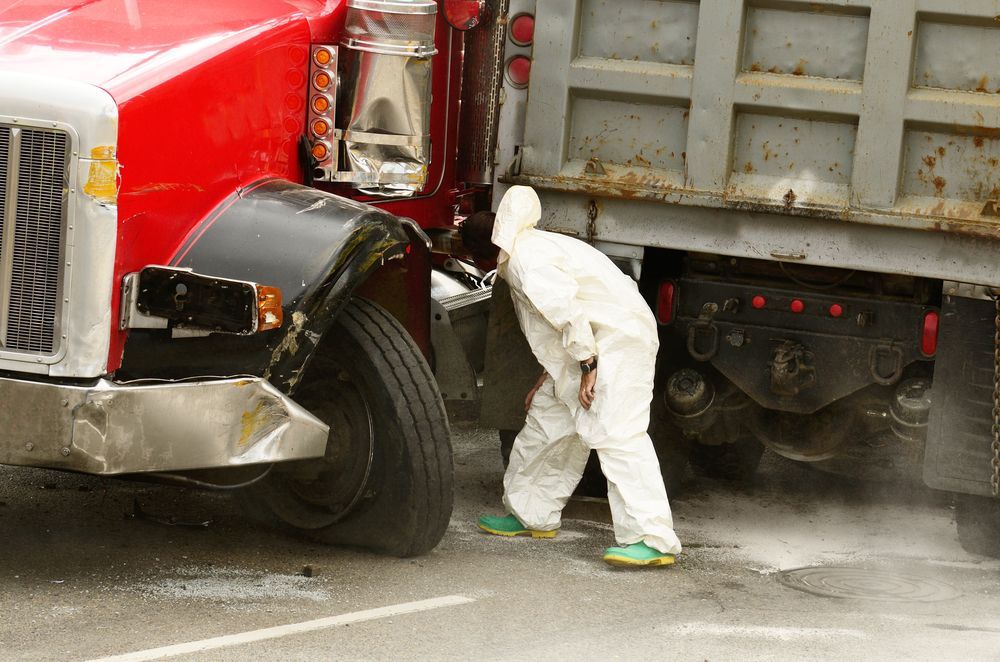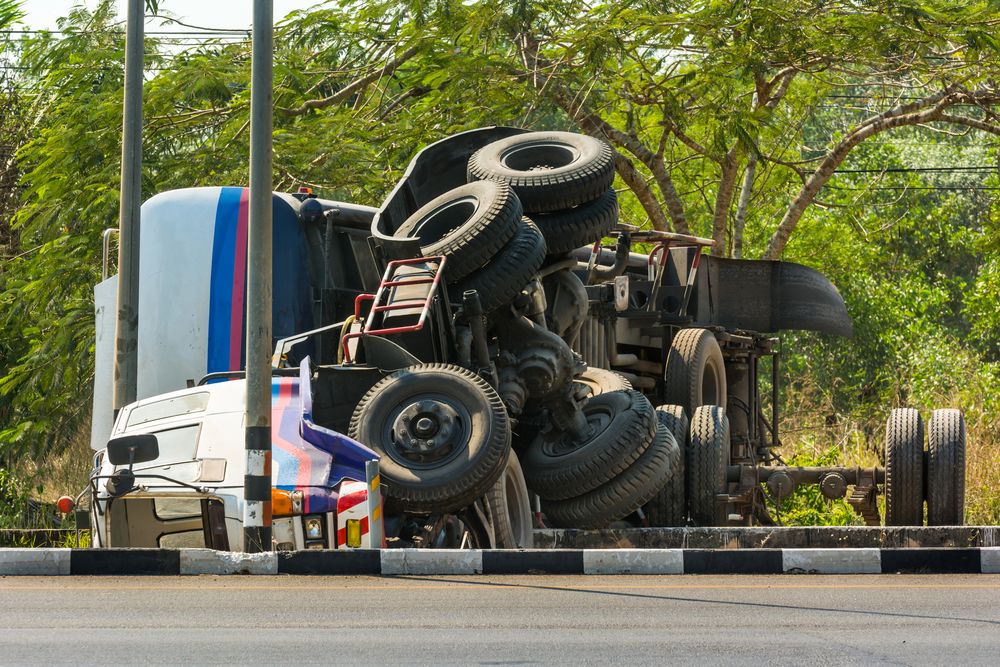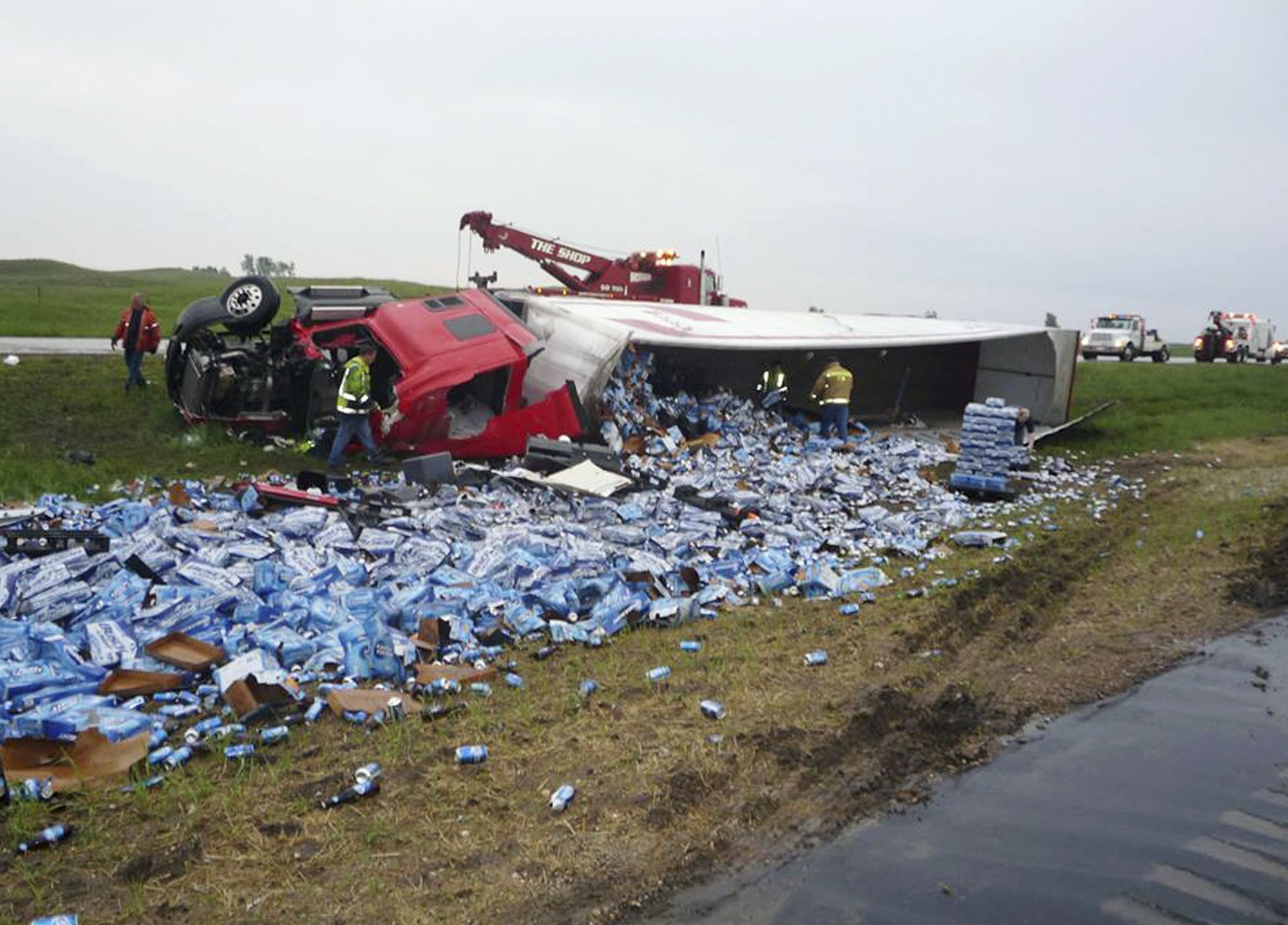(Bloomberg Business) -- It was almost midnight when Walter Priceeased his 18-wheeler into the right lane on Interstate 75 nearAtlanta. As he began to bank onto the exit ramp he’d been takingfor the past 10 years, Price had no idea he was entering America’smost dangerous hot zone for truck drivers.
|As Price rounded the curve onto Exit 238-B that cold night inFebruary 2012, a small black car darted in front of him on anotherwise deserted highway. The car’s driver slammed on the brakesto negotiate the exit’s sharp curve. Price had to veer left and hithis brakes to avoid a collision. But the curve was too sharp andPrice’s 36-ton rig carrying car parts began to roll.
|“Once you hear the freight break loose and start sliding,there’s absolutely nothing you can do,” the veteran truck driverrecalled. “You can kiss your ass goodbye.”
|[Related: Commercial truckers object to proposed increase inmandatory insurance minimum]
|Price was lucky. He survived his rollover; many others do not.Each year, hundreds of truck drivers die across the country oncongested roadways and antiquated exit ramps like the one wherePrice crashed, as a crumbling interstate highway system, designedin the mid-1950s, bears the ever greater burden of a boomingtrucking industry.
|When comedian Tracy Morgan suffered brain damage and his friendwas killed in a crash with a Wal-Mart Stores Inc. truck inJune, Americans were reminded how lethal a rolling 18-wheeler canbe for car passengers. Far less noticed are the rollovers that areespecially deadly for truck drivers.
||
(Photo: TFoxForto / Shutterstock.com)
|Though they accounted for just 3.3 percent of all large- truckcrashes, rollovers were responsible for more than half of thedeaths to drivers and their occupants in 2012, the most recent yearfor which data is available. That’s 300 truck occupant deaths and3,000 injuries every year. And among the 2.6 million workers in theU.S. who drive trucks that weigh more than 10,000 pounds (4,500kilograms), crashes are the leading cause of on-the-job death,according to the Centers for Disease Control and Prevention.
|Overworked, distracted and sleepy drivers are causes ofrollovers. But so too are outdated highway engineering and growinggridlock as trucking puts ever greater strain on the nation’s agingroadways. Truck tonnage hauled jumped to an all- time high inJanuary, the American Trucking Associations reported. Truck freightmay rise 5.3 percent this year from 4 percent in 2014, according toFTR Associates data compiled by Bloomberg, as job growth spurs U.S.consumer spending.
|The almost 10 billion tons of freight carried annually is takingsuch a toll on the nation’s highways that politicians of allstripes are angling to raise the money needed to fix them.Michigan’s Republican governor, Rick Snyder, has endorsed a ballotproposal to raise the sales tax to repair what he called hisstate’s “rotten roads and bridges.” Iowa’s Republican governor isalso considering higher taxes to cover road repairs.
|“Because so many curves were made 40 years ago, they don’t havethe banking needed for the trucks of today,” said Steve Niswander,vice president of safety policy at the Groendyke Transport truckingcompany in Enid, Oklahoma. “But to lengthen out and expandcloverleafs in probably 50 areas in the United States would takebillions—and I mean with a B.”
||
(Photo: Shutterstock)
|Nowhere do mid-century roadways and 21st century congestioncollide with such deadly force as in Atlanta, where a tangle oftwisting roadways and densely packed moving traffic combine tocreate America’s extreme tipping point. More than 200 trucks haveflipped around Atlanta since 2001, according to a study by theAmerican Transportation Research Institute. And more than 200people have died in truck rollovers in Georgia during thattime.
|The Top 10 rollover hot spots in the Atlanta area all involveexit ramps that require a rapid reduction in speed and often havesightlines obscured by bridges or the curvature of the road. Manylack adequate signs and flashing lights to warn of impendingrollover risk.
|A four-hour drive in a tractor-trailer around Atlanta revealsthe scars of past rollovers—black skid marks on concrete exit wallsand tractor-trailer-shaped dents in the grass along theroadside.
|“It’s a nightmare,” said Price, 61, who now refuses to return tothe intersection where he rolled and, instead, takes the long wayaround Atlanta. “The whole time you’re driving through there, youhave to be on defense.”
|Rolling up on the No. 1 hot spot, where Price flipped his truck,Herschal Evans, a driver based out of Atlanta for USF Holland,slows his fully loaded rig to less than 20 miles (32 kilometers)per hour. More than three dozen trucks have rolled since 2001 onthis ramp to westbound I-285 off I-75, just south of Atlanta, andthey’ve left their marks all over the scored earth along the curve.Two lanes feed into the exit, which is partially obscured by abridge overhead.
|“We can’t afford a bad day or an off day,” Evans said. “We’vegot to bat 1,000 every day. When we don’t bat 1,000, we standout.”
|The only warning of rollover risk at Exit 238-B is a smallyellow sign on the right shoulder of the road that displays animage of a tipping truck. Drivers in the left lane may never seethat sign. Even if they do, the warning comes too late, Evanssaid.
|“I’m not trying to excuse drivers,” he said. “But more warningswould help.”
||
(Photo: Shutterstock)
|Experiencing a rollover increases a truck driver’s risk of dyingin a crash by 30 times, according to University of Michiganresearch. Not wearing a seat belt makes it even worse. More than athird of drivers who died in crashes in 2012 were unbelted,according to the CDC. That helped drive up deaths among truckersbetween 2009 and 2012, after reaching a 35-year low six years ago,according to the CDC.
|“Rollovers can be quite violent at the last phase of it,” saidJohn Woodrooffee, a scientist at the University of MichiganTransportation Research Institute in Ann Arbor. “The trailer goesover first, and then it can wind up like a spring and snap the cabover. Ejection or partial ejection from the cab are the highestcauses of death.”
|The National Highway Traffic Safety Administration last monthsent a proposed rule to the White House for review that wouldmandate electronic stability control to take over braking on bigtrucks, like the technology now required on sport-utility vehicles,pickups and cars. While industry opposition has held up theregulation, NHTSA says it could save 60 lives a year and prevent2,329 crashes.
|“The delay is costing us lives,” said Woodrooffee, who conductedresearch for NHTSA for the proposed rollover regulation. “Without adoubt, electronic stability control is one of the most effectivecrash avoidance technologies for heavy trucks on the market.”
|European regulators require big trucks to be outfitted withelectronic stability control, which uses a variety of sensors toanticipate when a vehicle may tip and applies brakes to specificwheels or de-throttles the engine to prevent a rollover.
|Truckmakers already equip about 70 percent of new rigs with someform of stability control and are opposed to mandating the morecostly electronic technology as NHTSA is proposing, said Ted Scott,director of engineering for the American Trucking Associations.
|“I don’t think the mandate is going to change a damn thing untilall of the older tractors are off the road,” Scott said.
||
This Wednesday, June 11, 2014 photo provided by the SouthDakota Highway Patrol shows a semi-truck after it rolled onInterstate 29 near Summit, S.D., and dumped a trailer full of beercans into the highway's median. The South Dakota Highway Patrolsaid the driver fell asleep while heading north. The driver had notbeen drinking. He was wearing a seatbelt but suffered serious,non-life threatening injuries. (AP Photo/Courtesy of the SouthDakota Highway Patrol)
|In the U.S., crash prevention technology like stability control,along with greater seat-belt use, has helped to reduce overallhighway deaths by 21 percent since 2003, according tothe Insurance Institute for Highway Safety. Truckoccupant deaths, in part due to lax seat-belt use, have fallenless—16 percent since 2003.
|What hasn’t changed is the percentage of truckers who die inrollovers. It was 51 percent in 2003 and 52 percent in 2012,according to federal data analyzed by Arlington, Virginia-basedIIHS.
|The American Transportation Research Institute this year plansto test an in-cab alert system that will sound an alarm as a truckapproaches a danger zone. The organization, funded by the truckingindustry, has mapped out rollover hot spots in 39 states. It alsois working with the states to add warning signs.
|“Hopefully, five or 10 years down the road, we will see thenumber of rollovers way down,” said Rebecca Brewster, president ofthe Arlington, Virginia-based institute.
|Price said his rollover seemed to happen in slow motion. First,his trailer began to corkscrew. Then, the cab snapped over on itsside and the rolled rig tore through the grass beside the highwaycloverleaf.
|As soon as the truck came to a stop, Price unbuckled, fell fromhis seat and scrambled to the back of the cab, searching for hiswife, who had been sleeping there.
|“I couldn’t find her,” Price said. “I was throwing stuff uptoward the front of the truck to find her. It was scary.”
|An 80,000-pound truck can take a 10th of a mile to come to astop. At 60 mph, it’s covering 90 feet (27 meters) of road everysecond.
|If a truck driver gets cut off, “it takes him a second tounderstand he’s got to stop to get to his brakes, so he’s gone 90feet,” said Niswander of Groendyke Transport. “It takes anotherhalf-second to get his air brakes to work. So now he’s at 135 feetbefore he’s made any effort to stop.”
|While the Prices felt lucky to survive their rollover, they weredevastated financially. Price had to replace his destroyed truckand it took four weeks to get back on the road. Evenwith insurance, the total cost to him of a new truck and amonth of lost wages: $100,000.
|“We’re just coming out that now,” he said.
|The driver of the car who caused it all faced noconsequences.
|“He just kept on driving, like they always do,” Price said.“They create accidents and they keep on driving like nothinghappened. It’s brutal out here.”
|Copyright 2018 Bloomberg. All rightsreserved. This material may not be published, broadcast, rewritten,or redistributed.
Want to continue reading?
Become a Free PropertyCasualty360 Digital Reader
Your access to unlimited PropertyCasualty360 content isn’t changing.
Once you are an ALM digital member, you’ll receive:
- All PropertyCasualty360.com news coverage, best practices, and in-depth analysis.
- Educational webcasts, resources from industry leaders, and informative newsletters.
- Other award-winning websites including BenefitsPRO.com and ThinkAdvisor.com.
Already have an account? Sign In
© 2024 ALM Global, LLC, All Rights Reserved. Request academic re-use from www.copyright.com. All other uses, submit a request to [email protected]. For more information visit Asset & Logo Licensing.








